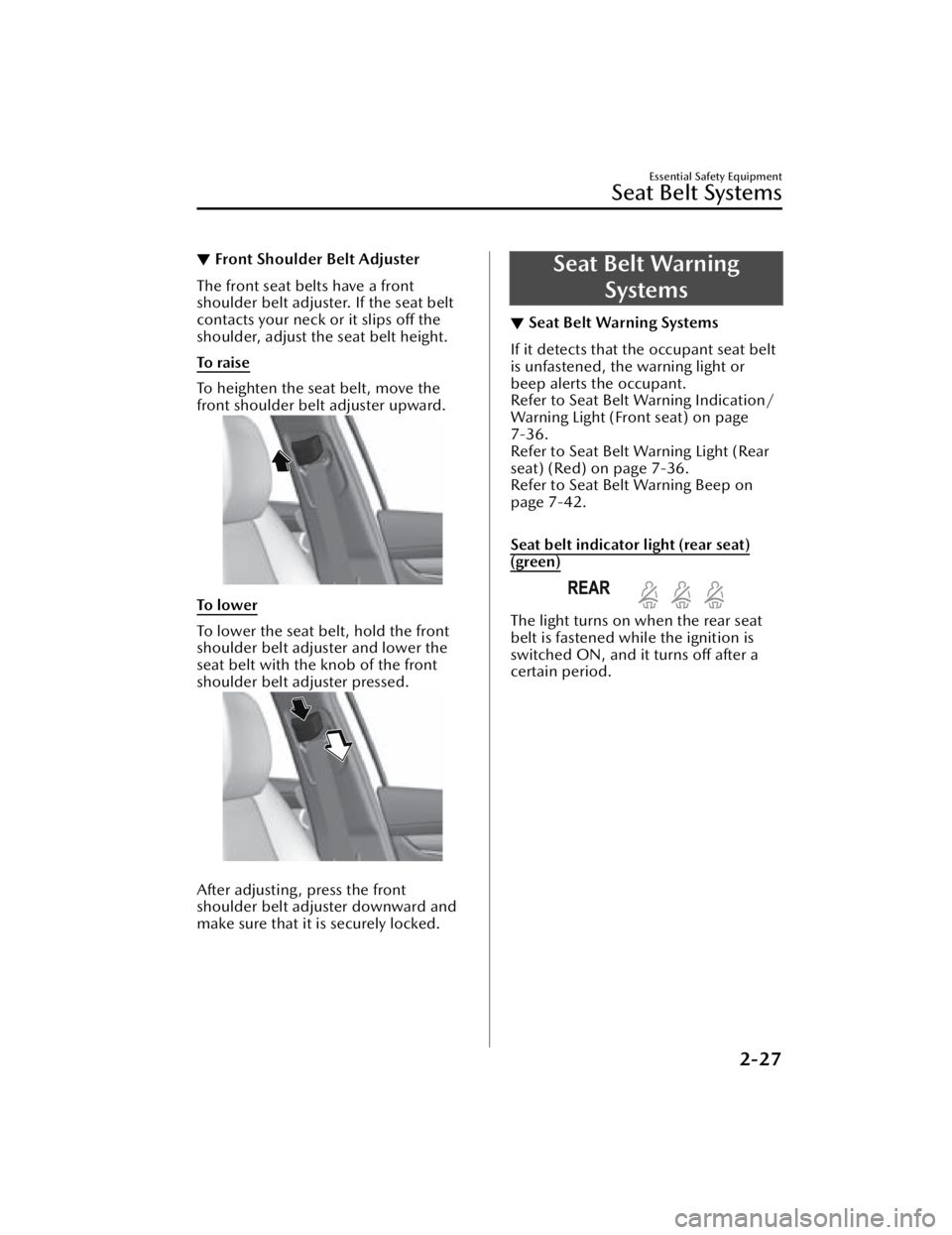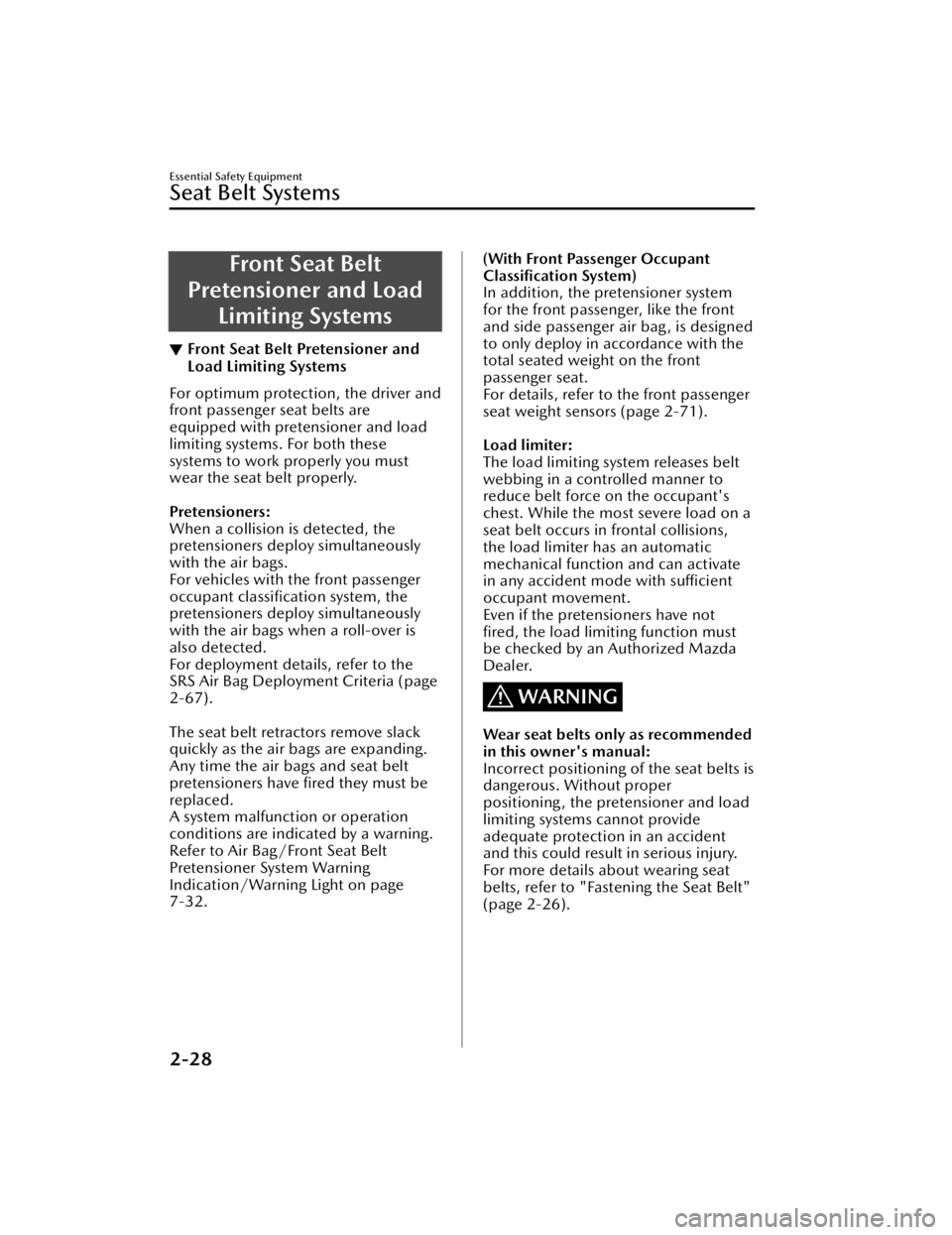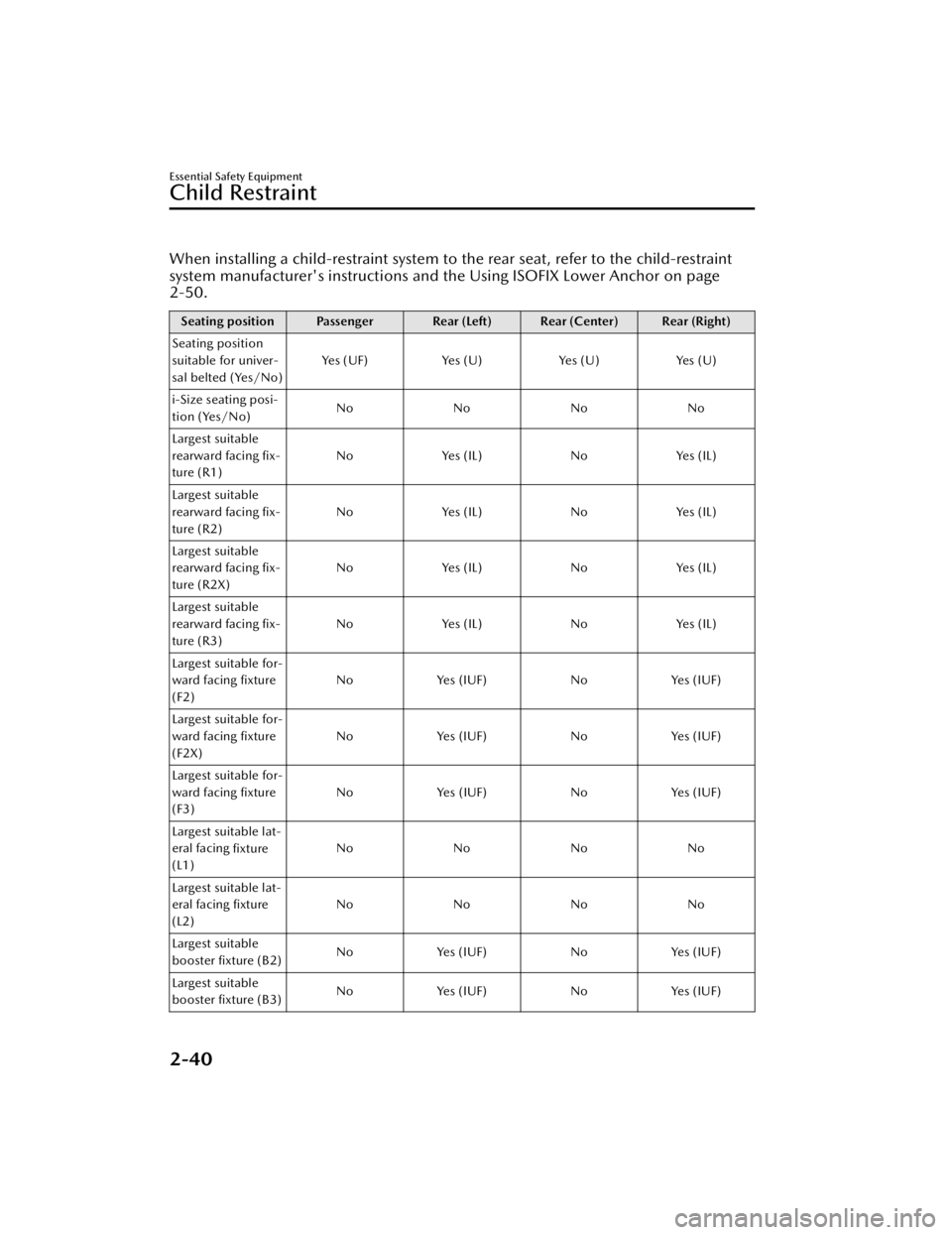Page 1 MAZDA MAZDA 2021 User Guide
[x] Cancel search | Manufacturer: MAZDA, Model Year: 2021, Model line: MAZDA, Model: MAZDA MAZDA 2021Pages: 612, PDF Size: 11.91 MB
Page 38 of 612

Do not operate a vehicle with a
damaged seat belt:
Using a damaged seat belt is
dangerous. An accident could damage
the belt webbing of the seat belt in
use. A damaged seat belt cannot
provide adequate protection in a
collision. Have an Authorized Mazda
Dealer inspect all seat belt systems in
use during an accident before they are
used again.
Have your seat belts changed
immediately if the pretensioner or
load limiter has been expended:
Always have an Authorized Mazda
Dealer immediately inspect the seat
belt pretensioners and air bags after
any collision. Like the air bags, the seat
belt pretensioners and load limiters
will only function once and must be
replaced after any collision that caused
them to deploy. A seat belt with an
expended pretensioner or load limiter
is still better than wearing no seat belt
at all; however, if the seat belt
pretensioners and load limiters are not
replaced, the risk of injury in a collision
will increase.
Positioning the Shoulder Portion of
the Seat Belt:
Improper positioning of the shoulder
portion of the seat belt is dangerous.
Always make sure the shoulder portion
of the seat belt is positioned across
your shoulder and near your neck, but
never under your arm, on your neck, or
on your upper arm.Positioning the Lap Portion of the Seat
Belt:
The lap portion of the seat belt worn
too high is dangerous. In a collision,
this would concentrate the impact
force directly on the abdominal area,
causing serious injury. Wear the lap
portion of the belt snugly and as low as
possible.
CAUTION
Belt retraction may become difficult if
the belts and rings are soiled, so try to
keep them clean. For more details
about cleaning the seat belts, refer to
"Seat Belt Maintenance" (page
6-54).
1. Ring
Essential Safety Equipment
Seat Belt Systems
2-24
Mazda3_8JM2-EA-20H_Edition2_new2020-8-19 13:13:07
Page 39 of 612

▼Pregnant Women and Persons with
Serious Medical Conditions
Pregnant women should always wear
seat belts. Ask your doctor for
specific
recommendations.
The lap belt should be worn SNUGLY
AND AS LOW AS POSSIBLE OVER THE
HIPS.
The shoulder belt should be worn
across your shoulder properly, but
never across the stomach area.
Persons with serious medical
conditions also should wear seat belts.
Check with your doctor for any special
instructions regarding specific medical
conditions.
▼ Emergency Locking Mode
When the seat belt is fastened, it will
always be in the emergency locking
mode.
In the emergency locking mode, the
belt remains comfortable on the
occupant and the retractor will lock in
position during a collision.
If the belt is locked and cannot be
pulled out, retract the belt once, and
then try pulling it out slowly. If this
fails, pull the belt strongly 1 time and
loosen, then pull it out again slowly.
(Seat Belt with Automatic Locking
Mode)
When the seat belt is fastened, it will
always be in the emergency locking
mode until it is switched to automatic
locking mode by pulling it all the way
out to its full length. If the belt feels
tight and hinders comfortable
movement while the vehicle is stopped
or in motion, it may be in the
automatic locking mode because the
belt has been pulled too far out. To
return the belt to the more
comfortable emergency locking mode,
wait until the vehicle has stopped in a
safe, level area, retract the belt fully to
convert it back to emergency locking
mode and then extend it around you
again.
▼
Automatic Locking Mode (Except
Mexico)
Always use the automatic locking
mode to keep the child-restraint
system from shifting to an unsafe
position in the event of an accident. To
enable seat belt automatic locking
mode, pull it all the way out and
connect it as instructed on the
child-restraint system. It will retract
down to the child-restraint system and
stay locked on it. See the section on
child restraint (page 2-44).
Essential Safety Equipment
Seat Belt Systems
2-25
Mazda3_8JM2-EA-20H_Edition2_new
2020-8-19 13:13:07
Page 41 of 612

▼Front Shoulder Belt Adjuster
The front seat belts have a front
shoulder belt adjuster. If the seat belt
contacts your neck or it slips off the
shoulder, adjust the seat belt height.
To ra i s e
To heighten the seat belt, move the
front shoulder belt adjuster upward.
To l o w e r
To lower the seat belt, hold the front
shoulder belt adjuster and lower the
seat belt with the knob of the front
shoulder belt adjuster pressed.
After adjusting , press the front
shoulder belt adjuster downward and
make sure that it is securely locked.
Seat Belt Warning
Systems
▼Seat Belt Warning Systems
If it detects that the occupant seat belt
is unfastened, the warning light or
beep alerts the occupant.
Refer to Seat Belt Warning Indication/
Warning Light (Front seat) on page
7-36.
Refer to Seat Belt Warning Light (Rear
seat) (Red) on page 7-36.
Refer to Seat Belt Warning Beep on
page 7-42.
Seat belt indicator light (rear seat)
(green)
The light turns on when the rear seat
belt is fastened while the ignition is
switched ON, and it turns off after a
certain period.
Essential Safety Equipment
Seat Belt Systems
2-27
Mazda3_8JM2-EA-20H_Edition2_new
2020-8-19 13:13:07
Page 42 of 612

Front Seat Belt
Pretensioner and Load Limiting Systems
▼Front Seat Belt Pretensioner and
Load Limiting Systems
For optimum protection, the driver and
front passenger seat belts are
equipped with pretensioner and load
limiting systems. For both these
systems to work properly you must
wear the seat belt properly.
Pretensioners:
When a collision is detected, the
pretensioners deploy simultaneously
with the air bags.
For vehicles with the front passenger
occupant classification system, the
pretensioners deploy simultaneously
with the air bags when a roll-over is
also detected.
For deployment details, refer to the
SRS Air Bag Deployment Criteria (page
2-67).
The seat belt retractors remove slack
quickly as the air bags are expanding.
Any time the air bags and seat belt
pretensioners have
fired they must be
replaced.
A system malfunction or operation
conditions are indicated by a warning.
Refer to Air Bag/Front Seat Belt
Pretensioner System Warning
Indication/Warning Light on page
7-32.
(With Front Passenger Occupant
Classification System)
In addition, the pretensioner system
for the front passenger, like the front
and side passenger air bag , is designed
to only deploy in accordance with the
total seated weight on the front
passenger seat.
For details, refer to the front passenger
seat weight sensors (page 2-71).
Load limiter:
The load limiting system releases belt
webbing in a controlled manner to
reduce belt force on the occupant's
chest. While the most severe load on a
seat belt occurs in frontal collisions,
the load limiter has an automatic
mechanical function and can activate
in any accident mode with sufficient
occupant movement.
Even if the pretensioners have not
fired, the load limiting function must
be checked by an Authorized Mazda
Dealer.
WARNING
Wear seat belts only as recommended
in this owner's manual:
Incorrect positioning of the seat belts is
dangerous. Without proper
positioning, the pretensioner and load
limiting systems cannot provide
adequate protection in an accident
and this could result in serious injury.
For more details about wearing seat
belts, refer to "Fastening the Seat Belt"
(page 2-26).
Essential Safety Equipment
Seat Belt Systems
2-28
Mazda3_8JM2-EA-20H_Edition2_new 2020-8-19 13:13:07
Page 43 of 612

Have your seat belts changed
immediately if the pretensioner or
load limiter has been expended:
Always have an Authorized Mazda
Dealer immediately inspect the seat
belt pretensioners and air bags after
any collision. Like the air bags, the seat
belt pretensioners and load limiters
will only function once and must be
replaced after any collision that caused
them to deploy. A seat belt with an
expended pretensioner or load limiter
is still better than wearing no seat belt
at all; however, if the seat belt
pretensioners and load limiters are not
replaced, the risk of injury in a collision
will increase.
Do not modify the components or
wiring, or use electronic testing
devices on the pretensioner system:
Modifying the components or wiring of
the pretensioner system, including the
use of electronic testing devices is
dangerous. You could accidentally
activate it or make it inoperable which
would prevent it from activating in an
accident. The occupants or repairers
could be seriously injured.
Properly dispose of the pretensioner
system:
Improper disposal of the pretensioner
system or a vehicle with
non-deactivated pretensioners is
dangerous. Unless all safety
procedures are followed, injury could
result. Have an Authorized Mazda
Dealer safely dispose of the
pretensioner system or scrap a
pretensioner system equipped vehicle.NOTE
The pretensioner system may not
operate depending on the type of
the collision. For details, refer to the
SRS Air Bag Deployment Criteria
(page 2-67).
Some smoke (non-toxic gas) will be
released when the air bags and
pretensioners deploy. This does not
indicate a fire. This gas normally has
no effect on occupants, however,
those with sensitive skin may
experience light skin irritation. If
residue from the deployment of the
air bags or the pretensioner system
gets on the skin or in the eyes, wash
it off as soon as possible.
Essential Safety Equipment
Seat Belt Systems
2-29
Mazda3_8JM2-EA-20H_Edition2_new 2020-8-19 13:13:07
Page 46 of 612

Child-RestraintPrecautions
▼ Child-Restraint Precautions
Mazda strongly urges the use of
child-restraint systems for children
small enough to use them.
You are required by law to use a
child-restraint system for children in
the U.S. and Canada.
Check your local and state or
provincial laws for specific
requirements regarding the safety of
children riding in your vehicle.
Whatever child-restraint system you
consider, please pick the appropriate
one for the age and size of the child,
obey the law and follow the
instructions that come with the
individual child-restraint system.
A child who has outgrown
child-restraint systems should sit in the
rear and use seat belts, both lap and
shoulder. If the shoulder belt crosses
the neck or face, move the child closer
to the center of the vehicle in the
outboard seats, and towards the
buckle on the right if
the child is seated
on the center seat.
Statistics confirm that the rear seat is
the best place for all children up to 12
years of age, and more so with a
supplemental restraint system (air
bags).
A rear-facing child-restraint system
should NEVER be used on the front
seat with the air bag system activated.
The front passenger's seat is also the
least preferred seat for other
child-restraint systems.
(With Front Passenger Occupant
Classification System)
To reduce the chance of injuries
caused by deployment of the front
passenger air bag, the front passenger
seat weight sensors occupant
classification sensor works as a part of
the supplemental restraint system. This
system deactivates the front passenger
front and side air bags and knee air
bags, and also the front passenger seat
belt pretensioner system when the
front passenger air bag deactivation
indicator light illuminates.
When an infant or small child sits on
the front passenger seat, the system
shuts off the front passenger front and
side air bags and knee air bags, and
seat belt pretensioner system, so make
sure the front passenger air bag
deactivation indicator light illuminates.
Even if the front passenger air bag is
shut off, Mazda strongly recommends
that children be properly restrained
and child-restraint systems of all kinds
are properly secured on the rear seats
which are the best place for children.
For more details, refer to "Front
passenger seat weight sensors" (page
2-71).
Essential Safety Equipment
Child Restraint
2-32
Mazda3_8JM2-EA-20H_Edition2_new 2020-8-19 13:13:07
Page 50 of 612

NOTE
Your Mazda is equipped with ISOFIX/
LATCH*1 lower anchors for attachment
of specially designed ISOFIX/LATCH*1
child-restraint systems on the rear
seats. When using these anchors to
secure a child-restraint system, refer to
"Using ISOFIX Lower Anchor
(Mexico)/Using LATCH Lower Anchor
(Except Mexico)" (page 2-50).
*1 ISOFIX (Mexico)/LATCH (Except Mexico)
Essential Safety Equipment
Child Restraint
2-36
Mazda3_8JM2-EA-20H_Edition2_new 2020-8-19 13:13:07
Page 53 of 612

Child-Restraint System Suitability for Various SeatPo s i t i o n s Ta b l e
▼Child-Restraint System Suitability
for Various Seat Positions Table
(Mexico)
Provided information in the table shows your child-restraint system suitability for
various seating position. For installation suitability of other manufacturer
child-restraint system, carefully consult the manufacturer's instructions which
accompany the child-restraint system.
When installing a child-re straint system, the following points must be observed:
Always remove the head restraint before installing a child-restraint system.
However, when installing a backless booster seat, always install the vehicle head
restraint to the seat where the backless b ooster seat is installed. In addition,
always use a tether strap and attach it securely. Refer to Head Restraints on page
2-17.
When installing a child-restraint system to the front passenger seat, adjust the seat
slide position as far back as possible.
Refer to Adjusting the Front Passenger's Seat on page 2-13.
When it is difficult to install a child-rest raint system to the front passenger seat, or
the seat belt cannot be secured to th e child-restraint system, perform the
following operations to adjust the seat ho lding the child-restraint system so that
the seat belt can be secured completely to it.
Move the seat forward or back.Move the seatback forward or back.Move the seat upward or downward. (Veh icles with height adjustment function)When installing a child-restraint system to the rear seat, adjust the front seat
position so that the front seat does not contact the child-restraint system.
Refer to Adjusting the Driver's Seat on page 2-5.
Refer to Adjusting the Front Passenger's Seat on page 2-13.
When installing a child-restraint system equipped with a tether, remove the head
restraint.
Refer to Head Restraints on page 2-17.
An i-Size child-restraint system refers to a child-restraint system which has
acquired i-Size category certification for the UN-R 129 regulation.
Essential Safety Equipment
Child Restraint
2-39
Mazda3_8JM2-EA-20H_Edition2_new 2020-8-19 13:13:07
Page 54 of 612

When installing a child-restraint system to the rear seat, refer to the child-restraint
system manufacturer's instructions and the Using ISOFIX Lower Anchor on page
2-50.
Seating position Passenger Rear (Left) Rear (Center) Rear (Right)
Seating position
suitable for univer-
sal belted (Yes/No) Yes (UF) Yes (U) Yes (U) Yes (U)
i-Size seating posi-
tion (Yes/No) No
No NoNo
Largest suitable
rearward facing fix-
ture (R1) No
Yes (IL) NoYes (IL)
Largest suitable
rearward facing fix-
ture (R2) No
Yes (IL) NoYes (IL)
Largest suitable
rearward facing fix-
ture (R2X) No
Yes (IL) NoYes (IL)
Largest suitable
rearward facing fix-
ture (R3) No
Yes (IL) NoYes (IL)
Largest suitable for-
ward facing fixture
(F2) No
Yes (IUF) NoYes (IUF)
Largest suitable for-
ward facing fixture
(F2X) No
Yes (IUF) NoYes (IUF)
Largest suitable for-
ward facing fixture
(F3) No
Yes (IUF) NoYes (IUF)
Largest suitable lat-
eral facing fixture
(L1) No
No NoNo
Largest suitable lat-
eral facing fixture
(L2) No
No NoNo
Largest suitable
booster fixture (B2) No
Yes (IUF) NoYes (IUF)
Largest suitable
booster fixture (B3) No
Yes (IUF) NoYes (IUF)
Essential Safety Equipment
Child Restraint
2-40
Mazda3_8JM2-EA-20H_Edition2_new 2020-8-19 13:13:07
Page 56 of 612

Installing Child-RestraintSystems
▼Installing Child-Restraint Systems
Accident statistics reveal that a child is
safer in the rear seat. The front
passenger's seat is clearly the worst
choice for any child under 12, and
with rear-facing child-restraint systems
it is clearly unsafe due to air bags.
NOTE
Even if your vehicle is equipped with
front passenger occupant classification
sensor (page 2-71), which
automatically deactivates the front
passenger air bag , a rear seat is the
safest place for a child of any age or
size.
Some child-restraint systems now
come with tethers and therefore must
be installed on the seats that take
tethers to be effective. In your Mazda,
tethered child-restraint systems can
only be accommodated in the three
positions on the rear seat.
Some child-restraint systems also
employ specially designed ISOFIX/
LATCH
*1 attachments; refer to "Using
ISOFIX Lower Anchor (Mexico)/Using
LATCH Lower Anchor (Except
Mexico)" (page 2-50).
*1 ISOFIX (Mexico)/LATCH (Except Mexico)
WARNING
Tethered Child-Restraint Systems
Work Only on Tether-Equipped Rear
Seats:
Installation of a tether equipped
child-restraint system in the front
passenger's seat defeats the safety
design of the system and will result in
an increased chance of serious injury if
the child-restraint system goes forward
without benefit of being tethered.
Place tether equipped child-restraint
systems where there are tether
anchors.
▼ Anchor Bracket
Anchor brackets for securing
child-restraint systems are equipped in
the vehicle. Locate each anchor
position using the illustration.
To install a child-restraint system,
remove the head restraint. Always
follow the instruction manual
accompanying the child-restraint
system.
Anchor bracket location
Use the indicated anchor bracket
locations when installing a
child-restraint system equipped with a
tether.
(4–Door)
1. For right
2. For center (Except Mexico)
3. For left
Essential Safety Equipment
Child Restraint
2-42
Mazda3_8JM2-EA-20H_Edition2_new
2020-8-19 13:13:07